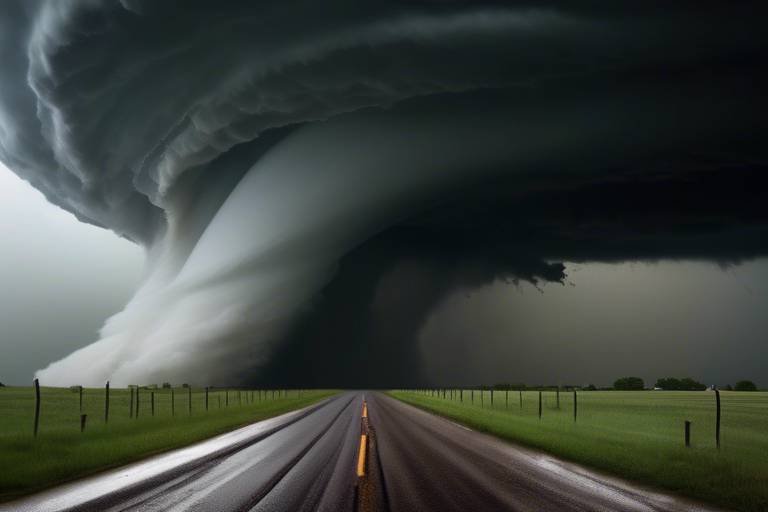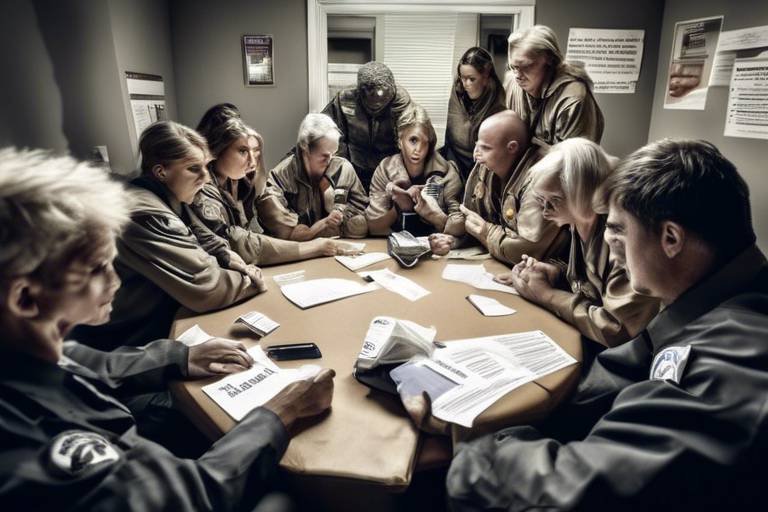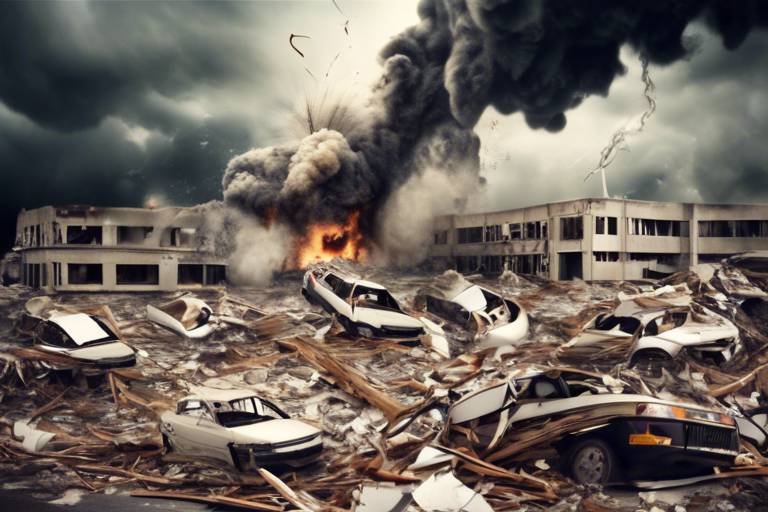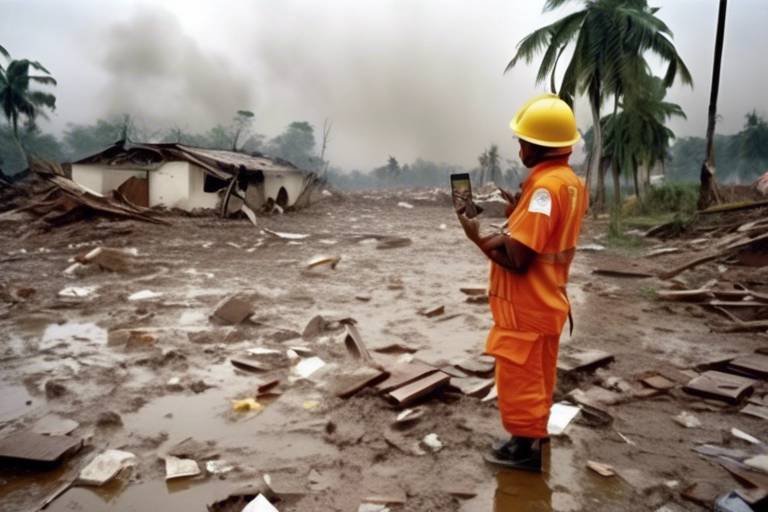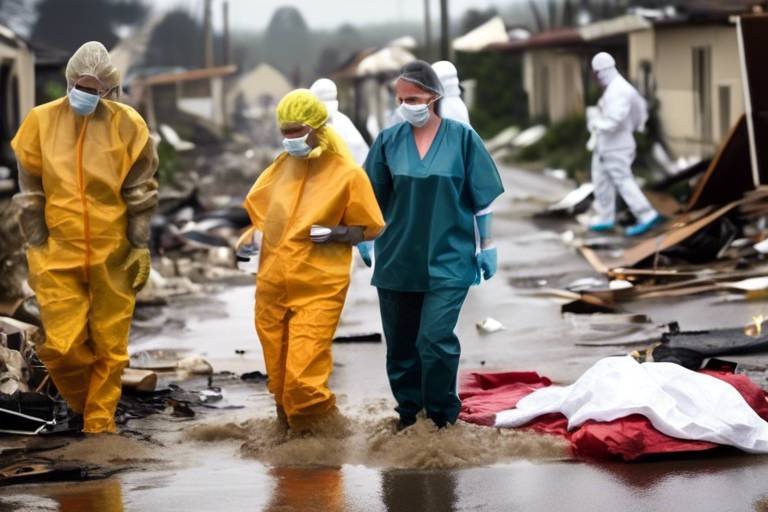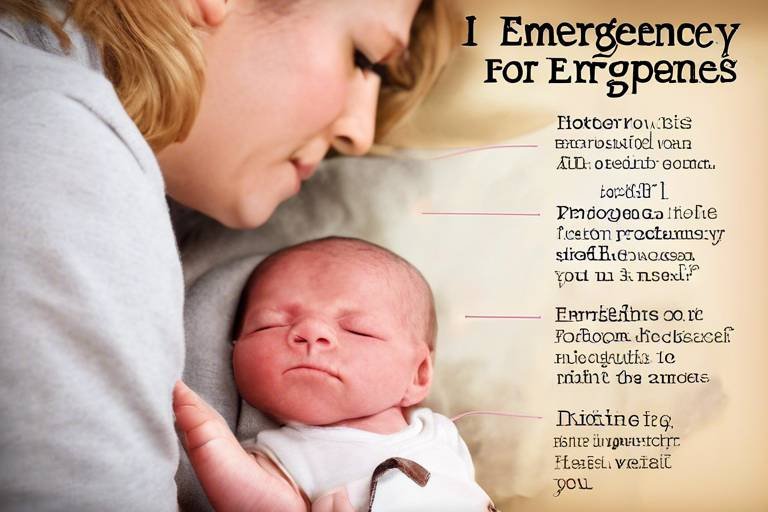How to Prepare for a Tornado - Key Steps
When the winds start howling and the skies turn ominous, the last thing you want is to be caught off guard by a tornado. Preparation is key, and it can mean the difference between life and death. In this article, we will walk you through essential steps to effectively prepare for a tornado, ensuring not only your safety but also minimizing damage to your property. From assembling an emergency kit to identifying safe locations, we've got you covered. So, let’s dive in and get ready to face Mother Nature head-on!
Before we jump into the nitty-gritty of preparation, it’s important to understand what tornadoes are. Tornadoes are rapidly rotating columns of air that extend from a thunderstorm to the ground. They form under specific conditions, typically when warm, moist air meets cool, dry air, creating instability in the atmosphere. The result? A swirling vortex that can wreak havoc in a matter of seconds. There are different types of tornadoes, ranging from weak, short-lived ones to the more powerful, destructive tornadoes that can cause catastrophic damage. Knowing the science behind tornadoes can help you recognize their potential dangers and prepare accordingly.
Now that you have a grasp on what tornadoes are, it’s time to create a comprehensive emergency plan. This plan should not only include communication strategies but also designated meeting places and specific roles for each family member. Imagine this: when the storm hits, you want everyone to know exactly what to do and where to go. Here’s how to get started:
- Communication: Establish how you will communicate during a tornado. Will you use cell phones, walkie-talkies, or a family radio?
- Meeting Places: Choose a couple of safe spots where your family can meet if you get separated.
- Roles: Assign roles to each member based on their age and abilities. For example, an adult might be responsible for the emergency kit while a child helps with pets.
By having a solid plan in place, you’ll feel more in control when the storm approaches.
One of the most crucial steps in tornado preparedness is building an emergency kit. This kit is your lifeline during a tornado, so it’s vital to have it ready to go. Start by including essential items such as:
- Water (at least one gallon per person per day for three days)
- Non-perishable food (enough for three days)
- Flashlight and extra batteries
- First aid kit
- Whistle (to signal for help)
Store your kit in a cool, dry place and check it regularly to ensure that items are not expired or damaged. Remember, it’s better to be over-prepared than underprepared!
Knowing where to go during a tornado can save lives. Identify safe locations in your home, workplace, and community. The best places to seek shelter are:
- Basements
- Interior rooms on the lowest floor (like bathrooms or closets)
- Storm shelters, if available in your area
Make sure everyone in your family knows these locations and practices getting there quickly. It’s like a fire drill but for tornadoes!
Staying informed about weather conditions is key to tornado preparedness. Make it a habit to monitor alerts through various channels. Here are some effective ways:
- Download weather apps on your smartphone that provide real-time alerts.
- Invest in a NOAA weather radio for continuous updates.
- Keep an eye on local news stations for updates.
By staying informed, you can act quickly when a tornado warning is issued, giving you and your family the best chance of staying safe.
Education is empowerment. Teaching your family members, especially children, about tornado safety is essential. Use simple language and engaging activities to explain:
- What tornadoes are and how they form
- Emergency procedures and safe locations
- The importance of staying calm during a storm
Consider role-playing scenarios to help them understand what to do when a tornado warning is issued. Make it fun, and you’ll help them remember!
Don’t forget about the power of community! Local organizations, emergency services, and support groups can provide assistance and information during severe weather events. Check out your local government’s website for resources on tornado preparedness and recovery. Joining community preparedness groups can also help you stay informed and connected.
Understanding what to do after a tornado is just as important as preparation. Once the storm has passed, it’s crucial to assess damage and avoid hazards. Stay away from downed power lines, and report them to authorities. If you must enter your home, wear sturdy shoes to protect against debris. Always listen to local officials for guidance on when it’s safe to return to your home.
Q: How can I stay updated on tornado warnings?
A: Use weather apps, NOAA radios, and local news stations to receive timely alerts.
Q: What should I do if I’m caught outside during a tornado?
A: Seek shelter in a sturdy building or lie flat in a low-lying area, covering your head.
Q: How can I help my community prepare for tornadoes?
A: Get involved in local preparedness programs and share information with neighbors.

Understanding Tornadoes
This article outlines essential steps to effectively prepare for a tornado, ensuring safety and minimizing damage. It covers everything from emergency kits to shelter options and community resources.
Tornadoes are one of nature's most violent phenomena, capable of causing severe destruction in a matter of minutes. But what exactly are tornadoes? At their core, tornadoes are rapidly rotating columns of air that extend from a thunderstorm to the ground. They form under specific conditions, primarily when warm, moist air meets cold, dry air, creating instability in the atmosphere. This interaction can lead to the development of supercell thunderstorms, which are often the breeding grounds for tornadoes.
There are several types of tornadoes, each with its own characteristics and potential dangers. Understanding these can help you appreciate the risks involved:
- Weak Tornadoes: These tornadoes are classified as EF0 to EF1 on the Enhanced Fujita Scale and typically cause less damage, with wind speeds ranging from 65 to 110 mph. They might uproot trees and damage roofs, but rarely cause severe injuries.
- Strong Tornadoes: Ranging from EF2 to EF3, these tornadoes can produce winds between 111 to 165 mph. They can cause significant damage to buildings, flip vehicles, and pose a serious threat to life.
- Violent Tornadoes: The most dangerous, EF4 to EF5 tornadoes, can have wind speeds exceeding 166 mph. These tornadoes can obliterate well-built homes, toss cars like toys, and create a path of devastation that can be miles long.
But how do we measure the strength of a tornado? The Enhanced Fujita Scale (EF Scale) is used to classify tornadoes based on the damage they cause. Here’s a brief overview:
| EF Rating | Wind Speed (mph) | Damage Description |
|---|---|---|
| EF0 | 65-85 | Light damage, such as broken tree branches and minor roof damage. |
| EF1 | 86-110 | Moderate damage, including roof loss and mobile homes overturned. |
| EF2 | 111-135 | Considerable damage, with roofs torn off well-constructed houses. |
| EF3 | 136-165 | Severe damage, including entire stories of houses destroyed. |
| EF4 | 166-200 | Devastating damage, with well-built houses leveled. |
| EF5 | Over 200 | Incredible damage, with strong frame houses picked up and carried considerable distances. |
Understanding these classifications can help you gauge the potential risks in your area. Tornadoes can occur anywhere in the world, but they are most frequent in the United States, particularly in a region known as "Tornado Alley." This area stretches from Texas to Nebraska and is notorious for its high tornado activity.
As we delve deeper into tornado preparedness, it’s crucial to recognize the signs of an impending tornado. Look for dark, often greenish skies, large hail, and a loud roar similar to a freight train. These indicators can provide vital seconds to seek shelter. Remember, being informed and prepared is your best defense against these unpredictable storms.
Developing a comprehensive emergency plan is crucial. This section will guide you through the steps of creating a plan that includes communication, designated meeting places, and roles for each family member.
An emergency kit is vital for survival during a tornado. Learn what essential items to include, how to store them, and tips for keeping your kit updated and ready for use.
Knowing where to go during a tornado can save lives. This section discusses how to identify safe locations in your home, workplace, and community, including basements and storm shelters.
Staying informed about weather conditions is key to tornado preparedness. This section explains how to monitor alerts through various channels, including apps, NOAA weather radios, and local news.
Educating family members about tornado safety is essential. This section covers how to teach children about tornadoes, emergency procedures, and the importance of staying calm during a storm.
Community resources can enhance your tornado preparedness. Learn about local organizations, emergency services, and support groups that can provide assistance and information during severe weather events.
Understanding what to do after a tornado is just as important as preparation. This section outlines safety measures to take after a tornado, including assessing damage and avoiding hazards.
Q: What should I do if I see a tornado?
A: Seek shelter immediately in a sturdy building, preferably in a basement or an interior room on the lowest floor away from windows.
Q: How can I stay informed about tornado warnings?
A: Use weather apps, NOAA weather radios, and local news channels to stay updated on severe weather alerts.
Q: What items should I include in my emergency kit?
A: Essential items include water, non-perishable food, a flashlight, batteries, a first-aid kit, and important documents.
Q: How can I help my community prepare for tornadoes?
A: Get involved with local emergency preparedness programs, share information, and participate in community drills.

Creating an Emergency Plan
When it comes to tornado preparedness, having a well-thought-out emergency plan can be your best ally. Think of it as your roadmap to safety, guiding you and your loved ones through the chaos that a tornado can bring. The first step in crafting this plan is to gather your family and discuss the importance of being prepared. You might ask, "What would we do if a tornado warning is issued?" This conversation is crucial and sets the stage for a proactive approach to safety.
Your emergency plan should include several key elements. Start with communication. Designate a primary and a backup method for contacting each other during a storm. For example, if you’re separated during a tornado, having a family member or friend outside the area as a point of contact can help keep everyone informed and safe. It’s also wise to establish a designated meeting place where everyone can regroup after the storm has passed. This could be a neighbor's house or a local community center that you all agree upon.
Next, assign specific roles to each family member. This is not just about delegating tasks; it’s about empowering everyone to take action when it counts. You might have one person responsible for gathering the emergency kit, while another checks on pets or elderly family members. Involving everyone in the planning process helps to ensure that no one feels overwhelmed when the storm hits.
To further enhance your plan, consider creating a visual guide that outlines your emergency procedures. This could be a simple poster that you hang in a common area of your home, detailing steps to take during a tornado warning, such as:
- Go to the designated safe location immediately.
- Bring your emergency kit.
- Stay tuned to weather updates via your phone or a NOAA weather radio.
It's also a good idea to practice your emergency plan regularly. Just like a fire drill, running through your tornado emergency procedures can help everyone feel more confident and prepared. You might even consider timing how long it takes to reach your safe location. This can be a fun family activity, but it also reinforces the importance of acting quickly when every second counts.
Lastly, don’t forget to review and update your emergency plan periodically. Life changes, and so might your family dynamics—new members, changes in pets, or even moving to a new home can all affect your plan. Make it a habit to revisit your plan at least once a year or whenever significant changes occur. Keeping your emergency plan fresh and relevant can make all the difference when a tornado strikes.

Building an Emergency Kit
When it comes to tornado preparedness, one of the most crucial steps is . This kit serves as your lifeline during a storm, providing essential supplies that can help you and your loved ones survive until help arrives. Imagine being caught in the chaos of a tornado without the basic necessities—it's a scenario no one wants to face. So, let’s dive into what you should include in your emergency kit and how to keep it ready for action.
Your emergency kit should be tailored to your family's specific needs, but there are some universal items that everyone should have. Start with the basics: you’ll need enough non-perishable food and water to last at least 72 hours. Think of items like canned goods, energy bars, and bottled water. It's like packing for a mini-vacation, but instead of a beach, you’re preparing for an unexpected storm.
Next, don’t forget about first aid supplies. A well-stocked first aid kit can make a world of difference in an emergency. Include items such as bandages, antiseptics, and any necessary medications. You never know when a small injury might occur amidst the chaos, and being prepared can alleviate a lot of stress. Additionally, consider adding personal hygiene items like wet wipes and hand sanitizer—because let’s face it, cleanliness is key even in a crisis!
Now, let’s talk about communication. In today's world, staying connected is vital. Make sure to include a battery-powered or hand-crank radio in your kit. This will keep you informed about weather updates and emergency instructions, even if the power goes out. Pair this with a stash of extra batteries to ensure your devices are always powered. It’s like having a lifeline to the outside world when everything else goes dark.
Storage is just as important as the contents of your kit. Use a sturdy, waterproof container to hold your supplies. This could be a plastic bin or a backpack that’s easy to grab and go. Make sure to check your kit every six months to replace expired food and medications. Just like your car, your emergency kit needs regular maintenance to perform when it counts.
Lastly, think about including some comfort items. During a tornado, emotions can run high, especially for children. A few comforting items like a favorite toy or a book can help ease anxiety. It’s like bringing a piece of home into the unknown, which can make all the difference in a stressful situation.
In summary, building an emergency kit is about more than just gathering supplies—it's about creating a sense of security and readiness. By preparing for the unexpected, you’re not just protecting yourself; you’re ensuring that your family can weather any storm that comes your way.
- What should I include in my emergency kit? Your kit should include non-perishable food, water, a first aid kit, a battery-powered radio, extra batteries, personal hygiene items, and comfort items.
- How often should I check my emergency kit? It's recommended to check your kit every six months to replace expired items and ensure everything is in working order.
- Where should I store my emergency kit? Store your kit in a cool, dry place that is easily accessible in case of an emergency. A waterproof container is ideal.

Identifying Safe Locations
When it comes to tornado preparedness, knowing where to go during a storm can be the difference between safety and disaster. It's crucial to identify safe locations in your home, workplace, and community. Think of it as having a secret hideout, but instead of a treehouse, it's a sturdy space that can shield you from the wrath of swirling winds and flying debris.
In your home, the safest place is typically a basement or an interior room on the lowest floor, away from windows. If you don't have a basement, consider a small room like a bathroom or a closet, ideally in the center of the house. The key is to avoid windows and exterior walls, which can easily be breached by strong winds. If you're in a mobile home, it's best to seek shelter in a nearby sturdy building, as mobile homes offer little protection.
For those at work, familiarize yourself with your building's emergency plan. Most workplaces will have designated safe areas, often located in basements or interior hallways. Make sure to communicate with your coworkers about these locations so that everyone knows where to go when the sirens start blaring. It's like having a game plan for a big sports match—everyone needs to be on the same page!
Don't forget about your community resources. Many towns have storm shelters specifically designed to withstand tornadoes. These shelters are often located in schools, community centers, or other public buildings. It's wise to locate these shelters ahead of time and even visit them if possible, so you know what to expect when it’s time to take cover.
Here’s a quick summary of safe locations to consider:
| Location Type | Safe Areas |
|---|---|
| Home | Basement, interior room, bathroom, closet |
| Workplace | Designated safe areas, basements, interior hallways |
| Community | Storm shelters, community centers, schools |
Remember, preparation is not just about having a plan; it’s about knowing your surroundings. Take the time to walk through your home, office, and community to identify these safe spots. When a tornado warning is issued, you won’t have time to think—your instincts will kick in. By being proactive and familiarizing yourself with safe locations, you can ensure that you and your loved ones are ready to take cover when it matters most.
In conclusion, identifying safe locations is a crucial step in tornado preparedness. Whether you’re at home, work, or in your community, knowing where to go can help you react quickly and stay safe. So, take a moment today to map out your escape routes and safe spots. You’ll thank yourself later when the winds start howling!

Monitoring Weather Alerts
When it comes to tornado preparedness, one of the most crucial steps is staying informed about weather conditions. Tornadoes can develop rapidly, often with little warning, so knowing how to monitor weather alerts is essential for your safety. There are several effective ways to keep track of the latest weather updates, ensuring that you and your loved ones are always in the loop.
First and foremost, consider downloading a reliable weather app on your smartphone. These apps can provide real-time updates, alerts, and even radar images that show storm movements. Some popular options include Weather Underground, AccuWeather, and the National Weather Service app. Make sure to enable push notifications so you receive alerts as soon as they are issued. This way, you'll be among the first to know if a tornado watch or warning is in effect.
Another valuable tool for monitoring severe weather is a NOAA Weather Radio. These radios are specifically designed to broadcast continuous weather information directly from the National Oceanic and Atmospheric Administration. They provide alerts for severe weather, including tornadoes, and can be a lifesaver during emergencies when other communication methods may fail. Investing in a battery-operated or hand-crank NOAA Weather Radio ensures that you have access to vital information, even during power outages.
In addition to apps and radios, it's also wise to stay connected to local news channels. Many news stations offer live coverage during severe weather events, providing updates on tornado paths and safety recommendations. You can watch these broadcasts on television or stream them online through various platforms. By keeping an eye on local news, you can gain insights into the situation as it unfolds and make informed decisions about your safety.
To help you understand the different types of alerts you might encounter, here’s a brief overview:
| Alert Type | Description |
|---|---|
| Tornado Watch | Conditions are favorable for tornadoes to form. Stay alert and be prepared for possible warnings. |
| Tornado Warning | A tornado has been sighted or indicated by radar. Take shelter immediately! |
Lastly, don't forget the power of social media. Following local meteorologists and emergency management agencies on platforms like Twitter or Facebook can provide quick updates and important information. These channels often share live updates, safety tips, and community resources that can be invaluable during a tornado event.
In summary, monitoring weather alerts is a key component of tornado preparedness. By utilizing weather apps, NOAA Weather Radios, local news, and social media, you can stay informed and ready to act when severe weather strikes. Remember, the goal is to ensure your safety and the safety of your loved ones. Don't wait for the storm to hit—start preparing today!
Q: What should I do if I receive a tornado warning?
A: If you receive a tornado warning, seek shelter immediately in a safe location, such as a basement or an interior room on the lowest floor of your home. Avoid windows and cover yourself with a heavy blanket or mattress.
Q: How can I prepare my family for tornado alerts?
A: Educate your family about the different types of alerts, create an emergency plan, and practice drills so everyone knows what to do when a tornado warning is issued.
Q: Are there specific apps recommended for tornado alerts?
A: Yes, some highly recommended apps include the National Weather Service app, AccuWeather, and Weather Underground, which provide timely alerts and updates.

Educating Your Family
When it comes to tornado preparedness, knowledge is your family's best friend. Think about it: if a tornado warning suddenly interrupts your day, would your loved ones know what to do? Educating your family about tornado safety is not just a good idea; it's a necessity. You want to ensure that everyone, from the youngest to the oldest, understands the risks and knows the steps to take when the skies start to darken.
Start by having open conversations about tornadoes. Explain what they are in simple terms—think of a tornado as nature's way of showing off its power, like a spinning top gone wild! You can describe how they form from thunderstorms and how they can vary in strength and size. This knowledge will help demystify the storm and reduce fear, making it easier for everyone to stay calm when it matters most.
Next, create a family emergency plan that outlines specific actions to take in the event of a tornado. This should include:
- Designated safe locations within your home, such as a basement or an interior room on the lowest floor.
- A communication plan that details how you will contact each other if separated.
- Meeting points in case you need to evacuate or if you cannot return home.
Don't forget to practice! Just like fire drills in school, conducting tornado drills at home will help everyone remember what to do. You might even want to role-play different scenarios. For instance, ask your kids how they would react if they heard the tornado siren. This kind of practice can be both educational and fun, reinforcing the seriousness of the situation while alleviating anxiety.
In addition to practical drills, consider using educational resources. There are numerous websites, videos, and books that explain tornado safety in engaging ways. For younger children, you might find animated videos that explain tornadoes and safety tips in a way that captivates their imagination. For older kids, interactive apps can provide real-time weather updates and safety information, making them feel more involved in the process.
Another important aspect is teaching your family to stay informed. Discuss how to monitor weather alerts through various channels, such as local news broadcasts, weather apps, and NOAA weather radios. Make it a family habit to check the weather together, especially during storm season. This not only keeps everyone informed but also fosters a sense of teamwork and shared responsibility.
Finally, remind your family that staying calm is crucial during a tornado. Emphasize the importance of listening to instructions and supporting one another. Encourage your kids to express their feelings and fears, and reassure them that being prepared is the best way to stay safe. Ultimately, by educating your family about tornadoes and safety measures, you are empowering them to act decisively and confidently when it counts.
Q: How can I help my children cope with their fear of tornadoes?
A: Start by educating them about tornadoes in a way that is age-appropriate. Use stories, videos, and discussions to explain what tornadoes are and how to stay safe. Reassure them that being prepared is the best way to feel secure.
Q: What should I include in my family emergency plan?
A: Your emergency plan should include safe locations in your home, a communication strategy, and designated meeting points. Make sure every family member knows their role and the steps to take during a tornado warning.
Q: How often should we practice tornado drills?
A: It's a good idea to practice tornado drills at least twice a year, especially before the storm season. This keeps the information fresh in everyone's mind and helps reduce panic during an actual emergency.

Community Resources and Support
When it comes to tornado preparedness, **community resources and support** play a pivotal role in ensuring safety and effective response. No one wants to face a tornado alone, and having a network of support can make all the difference. Local organizations, emergency services, and community groups are invaluable assets that can provide assistance and vital information during severe weather events. Think of them as your safety net—ready to catch you when the storm hits.
First and foremost, it's essential to connect with your local **emergency management office**. These offices are often the first line of defense when disaster strikes. They provide updates on weather conditions, evacuation routes, and shelters. Knowing where to find this information can save precious time when every second counts. Many communities also have **alert systems** that send notifications directly to your phone or email. Signing up for these alerts can keep you informed about tornado watches and warnings in real-time.
Additionally, consider reaching out to local **nonprofit organizations** that specialize in disaster relief. Groups like the Red Cross offer resources such as emergency shelters and food distribution during and after a tornado. They often conduct training sessions on how to prepare for severe weather, which can be a fantastic opportunity to learn from experts and ask questions. Participating in these programs not only equips you with knowledge but also connects you with others who are similarly focused on safety.
Another great resource is your **community center**. Many centers host workshops and informational sessions about disaster preparedness. They can provide a wealth of local knowledge, such as identifying safe zones in your area and understanding the specific risks associated with tornadoes in your region. Plus, they often have bulletin boards filled with information about upcoming events, including training sessions and community drills.
Don't forget about the power of social media and local news outlets. Following your city or county's official social media pages can provide you with timely updates and resources. Local news stations often have meteorologists who specialize in severe weather coverage, offering insights that can help you prepare. Engaging with these platforms can also help you feel more connected to your community during stressful times.
Lastly, consider forming or joining a **neighborhood preparedness group**. This can be as simple as gathering a few neighbors to discuss emergency plans or as organized as creating a community response team. By pooling resources and knowledge, you can enhance your collective preparedness. Think of it like a potluck dinner—everyone brings something to the table, making the meal (or in this case, the preparedness plan) richer and more effective.
In conclusion, leveraging community resources and support is a critical component of tornado preparedness. By connecting with local organizations, participating in training sessions, and fostering relationships with your neighbors, you can create a robust safety network that will serve you well when the winds start to howl. Remember, in times of crisis, **community is everything**.
- What should I do if a tornado is approaching? Seek shelter immediately in a safe location, such as a basement or an interior room without windows.
- How can I stay informed about tornado warnings? Sign up for local alert systems, monitor weather apps, and follow local news stations.
- What resources are available for tornado recovery? Local nonprofits, emergency services, and community centers can provide assistance and information.

Post-Tornado Safety Measures
After a tornado has swept through your area, it’s crucial to understand the immediate steps you need to take to ensure your safety and the safety of those around you. The aftermath of such a powerful natural disaster can be chaotic and overwhelming, but being prepared can make a significant difference. First and foremost, check yourself and those around you for injuries. If anyone is hurt, it’s essential to seek medical help right away. However, be cautious when moving around, as there may be hidden dangers.
Next, assess your surroundings. Tornadoes can leave behind a trail of destruction, so it’s vital to be aware of your environment. Look out for downed power lines, as they can pose serious threats. If you see a downed line, do not approach it and report it to the authorities immediately. Also, be on the lookout for gas leaks. If you smell gas or hear a hissing sound, evacuate the area and contact the gas company.
Once you’ve ensured your immediate safety, it’s time to assess the damage to your property. Take photos of any damage for insurance purposes, as this will help you when filing claims. Documenting the aftermath can also be beneficial for local authorities who may need to assess the overall impact on the community.
In addition to assessing damage, be sure to stay informed. Monitor local news channels and weather updates to receive information about ongoing safety measures and recovery efforts. This is also a great time to check in with neighbors and see how they are faring. Community support can be invaluable during recovery, so don’t hesitate to lend a hand or ask for help if needed.
Furthermore, it’s important to avoid entering buildings that may have been compromised. If you suspect a building has sustained structural damage, wait for professionals to assess it before you go inside. Safety should always be your top priority.
Lastly, consider reaching out to local emergency services or community organizations that can provide assistance. Many places have resources available for those affected by natural disasters, including shelters, food assistance, and counseling services. Connecting with these resources can aid in your recovery and help you navigate the challenges ahead.
- What should I do first after a tornado? Check for injuries and ensure your immediate safety before assessing damage.
- How can I report downed power lines? Do not approach them; contact local authorities or the utility company immediately.
- Is it safe to enter damaged buildings? Only enter if you are sure they are structurally sound; otherwise, wait for professionals.
- Where can I find community resources for recovery? Reach out to local emergency services or organizations that assist with disaster recovery.
Frequently Asked Questions
- What should I include in my emergency kit for a tornado?
When preparing your emergency kit for a tornado, it's essential to include items that will keep you safe and comfortable during and after the storm. Some must-have items are:
- Water (at least one gallon per person per day for three days)
- Non-perishable food (enough for at least three days)
- Flashlight with extra batteries
- First aid kit
- Whistle to signal for help
- Dust mask to help filter contaminated air
- Moist towelettes, garbage bags, and plastic ties for personal sanitation
- Local maps
- Cell phone with chargers and a backup battery
- How can I monitor tornado warnings effectively?
Staying informed about tornado warnings is crucial for your safety. Here are some effective ways to monitor weather alerts:
- Download weather apps on your smartphone that provide real-time alerts.
- Purchase a NOAA weather radio for continuous broadcasts of weather information.
- Follow local news stations on social media for updates.
- Join community alert systems that send text or email notifications.
- What are the safest places to take shelter during a tornado?
Identifying safe locations in advance can save lives during a tornado. The safest places to take shelter include:
- Basements or storm cellars
- Interior rooms on the lowest floor, away from windows (like bathrooms or closets)
- Designated storm shelters in your community
- If outdoors, find a low-lying area such as a ditch, but protect your head and neck.
- How can I educate my family about tornado safety?
Teaching your family about tornado safety is vital. Here are some ways to educate them:
- Conduct regular family discussions about tornado preparedness.
- Practice your emergency plan through drills.
- Explain the signs of a tornado and how to respond.
- Use engaging resources like videos or children's books about tornado safety.
- What should I do immediately after a tornado?
After a tornado, your safety is still a priority. Here are steps to take:
- Check yourself and others for injuries and provide first aid if necessary.
- Stay tuned to local news for updates and emergency information.
- Avoid downed power lines and report them to authorities.
- Inspect your home for damage, but be cautious of hazards like gas leaks or structural damage.

